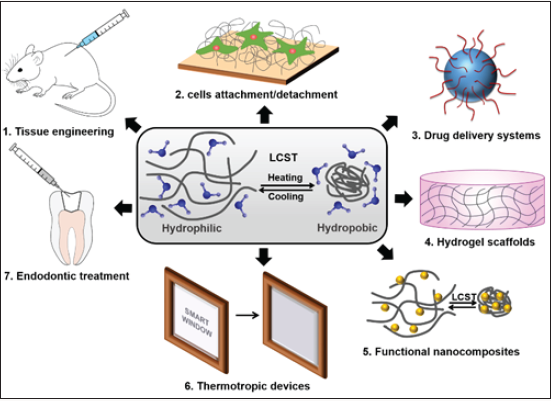Lupine Publishers| Journal of Nano medicine
Introduction
Typical chronical diseases are arthritis, circulatory problems, cancer, osteoporosis, diabetes, problems of locomotion due to trauma and falls, as well as oral healthy. On the other hand, “lifestyle” diseases related to tobacco and alcohol abuse accounts for a rising share of deaths of relatively young people. Additionally, non communicable diseases, such as circulatory-system ailments, cancers, and psychiatric disorders, are expected to replace infectious diseases and child malnutrition as the greatest contributors to the global disease burden [1]. During the last decade, nanotechnology revolutionized human life in aspects never though by Feynman in its famous conference “There´s plenty of room at the bottom” [2]. The possibility to induce, enhance or modify properties of materials used in our ordinary life or in incredibly sophisticated applications opened a new road for creative technologies in materials science, chemistry and medicine.
Nanotechnology is one of the promising fields for engendering new applications in energy, environmental and health, which represent three of the greatest challenges facing humanity in this century. By assembling materials at the nano scale, exceptional properties improvements can be obtained, which play a strategic role in our technological society3touching aspects that are quite far from our eyes. Selective biosensors for cancer cells, smart nano composites for transport and drug delivery, functional nanoparticles for cancer therapy and image, scaffolds for tissue engineering, and nano structured materials for implants, bones prosthesis and dental uses, can be used as good examples of effective bio functional materials based on nanotechnology.
The design and discovery of new functional materials involve a mixture of clever chemical intuition, rational assessment of the technical requirements, and substantial experimental efforts [4]. The complete development cycle, from scientific concept to marketing practice, takes time and requires a huge amount of resources. Once the material is sufficiently understood, new applications in different commercial fields is just a matter of creative and boldness. For instance, we successfully developed a nontoxic thermosensitive hydrogel based on poly (N-vinylcaprolactam) with a lower critical solution temperature (LCST) (Figure 1) [5]. This hydrogel (also referred to as PNVCL) exhibits a phase transition near the body temperature from a hydrophilic and water-soluble phase at low temperatures to an insoluble hydrophobic state when heated.
Its cyto compatibility and fast response to temperature stimuli allow its use as injectable hydrogel for tissue engineering [1]. Changes in the PNVCL molecular weight and concentration enabled the development of hydrogels with tunable mechanical properties and fast gelation times to support cartilage specific extracellular matrix production both in vitro and in vivo. PNVCL can also be obtained by initiated chemical vapor deposition on substrates for cell sheet engineering, excluding the use of conventional enzymatic treatments [2]. [6]Thermosensitive hydrogels are also suitable for drug delivery systems, including those modified with magnetic nanoparticles against pathogenic oral bio films, usually employing well-known antibiotics such as chlorhexidine but also some flavonoids and antimicrobial peptides [3]. The replacement of injured or malfunctioning natural organs or tissues by a natural substitute requires transplantation of an acceptable, healthy substitute.
Figure 1: Multi-purpose functional materials can be applied
in different uses. Thermosensitive poly (N-vinylcaprolactam), for
example, has been used as injectable hydrogel for tissue engineering
(1), as substrates for cell growth (2), in drug delivery systems (3), as
scaffolds to fabricate ‘bio artificial’ or ‘bio hybrid’ synthetic
organs (4), as functional nano composites (5), smart windows (6), and
for dentistry treatments (7).

According to World Health Organization,7 126.670 of solid
organs were transplanted in 2014, which is less than 10% of
global needs. Almost 25% of all transplants occurred in USA,
followed by China (7,9 %), Brazil (6,2 %) and France (4,5 %).In
fact, hydrogels can be used for engineered tissue scaffolds or to
fabricate ‘bio artificial’ or ‘bio hybrid’ synthetic organs due to their
unique compositional and structural similarities to the natural
extracellular matrix to repair organs injuries and regenerate organs
[4]. Beyond complexes uses for health, thermosensitive hydrogels
can be modified using functional nanoparticles, such as noble metal,
magnetic ferrites, bioactive glasses or porous silica for different
purposes, from drug transport and delivery, coatings for packaging,
biosensors or optical applications [5], which include passive and
active thermo tropic devices used in smart windows [6].
Finally, special attention should be dedicated for dental applications against C. albicans and S. mutans biofilms, cariogenic species generally responsible for dental caries. Perhaps the greatest challenge to obtain effective multi-purpose functional materials is to build a multidisciplinary collaboration network of chemists, engineers, dentists, biologists, physicians from academy but including also marketing experts and professionals from industry. Innovative ideas and creative solutions are at interfaces among specialties.
For more Open
Access Journal of Nanomedicine articles Please Click Here:
Follow on Twitter: https://twitter.com/lupine_online
Follow on Blogger : https://lupinepublishers.blogspot.com/


No comments:
Post a Comment